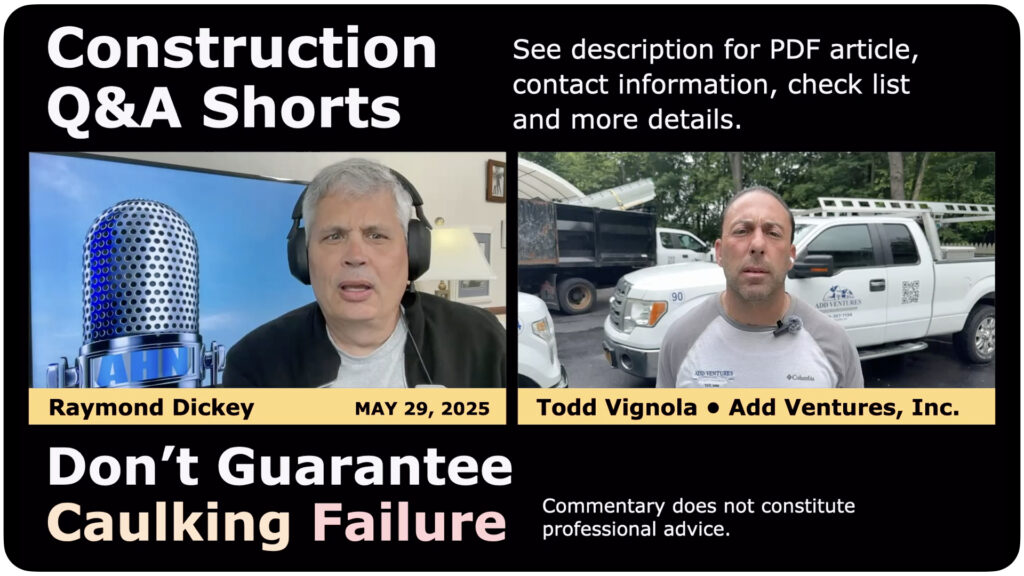Don’t Guarantee Caulking Failure
By AssociationHelpNow
Featuring: Raymond Dickey (AssociationHelpNow) & Todd Vignola (Add Ventures)
When it comes to re-caulking projects on buildings, too many boards and managers walk away with a cosmetic fix—only to face premature failure of the joint repairs a year or two later. Why? Because essential quality control steps were skipped.
During a recent segment of an AssociationHelpNow livestream, Raymond Dickey asked the key question:
“What quality control measures—like backer rod use, substrate preparation, and proper cure time—should boards and managers insist on during re-caulking projects?”
His follow-up drove the point home: boards want more than just “a better appearance.” They want a long-lasting repair. But for that to happen, they need to know what to look for—and what to demand.
Enter Todd Vignola, president of Add Ventures, who broke it down in practical terms:
First: Know What a Backer Rod Is
“A backer rod is simply a tubular form of insulation,” Vignola explained. It’s used to fill voids before caulking is applied, especially when joints are wider than ideal. “You don’t want to put a thick bead of caulk into a deep gap,” he warned. Instead, fill the space with backer rod first, then apply a smaller, more effective bead of caulk on top.
Substrate Prep Is Critical
Of all the factors that can determine whether a caulking project succeeds or fails, preparation of the surface (the “substrate”) is the most important. “If you don’t remove the previous caulk, don’t remove chipping or flaking paint, and don’t make sure the underlying material is in good condition, then caulking will be a complete failure,” Vignola stated.
Don’t Ignore Cure Time
Another commonly overlooked step is allowing the caulk enough time to dry—especially when working with acrylic or latex caulks. “You don’t want to apply caulk knowing it’s going to rain two hours later,” Vignola cautioned.
While some products dry in a couple of hours, optimal conditions call for 24 to 48 hours of dry weather to ensure a proper cure.
Final Word to Boards & Managers:
When budgeting for or overseeing a re-caulking project, it’s not just about product selection—it’s about process. Insist on:
- Proper surface preparation
- Use of backer rod for larger gaps
- Scheduled work based on weather forecasts for optimal cure time
Skipping these steps might save time up front—but it practically guarantees failure later. And that’s a guarantee no one wants.
Contacts:
Todd Vignola
Add Ventures, Inc.
Hillburn, NY
tvignola@addventuresinc.com
www.addventuresinc.com
Raymond Dickey
AssociationHelpNow
ray@brainerdcommunications.com
www.AssociationHelpNow.com
YouTube Short:
https://youtube.com/shorts/KEfeCYB99QM?feature=share
PDF Article:
https://files.constantcontact.com/8d350562101/70d78530-24aa-4014-b4df-6ca2da175416.pdf
GoToWebinar Video:
https://www.gotostage.com/channel/44207b5513cb401e8731a1bb42a2da23/recording/f51fd74972ac4e959862f5d72ace00ec/watch
Disclaimer: This content is provided for informational purposes only and does not constitute professional advice. It has been generated using the GoToWebinar system and assisted by artificial intelligence; therefore, accuracy is not guaranteed. This summary is offered as a courtesy to highlight the significance of the discussed topic and encourage viewers to revisit the recorded livestream for full context. Always consult your legal, accounting, or other qualified professionals before making any decisions or taking action based on this content.







